List of Authors
>>About this blog
Recent blog post
|
[Grandpa]
August 23, 2014 09:00
I saw a recent correspondent blog introducing a wonderful view of the Sumida River.
Immediately, I went to enjoy the scenery and atmosphere.
As you follow Ningyocho-dori in the direction of Suitengu, the Sumida River Ohashi is built beyond it.
The Kiyosu Bridge upstream is built across the Sumida River Ohashi, and the Eitai Bridge is built downstream.
Both Kiyosu Bridge and Eitai Bridge were designated as national cultural properties in June 2007, so they were designated as national cultural properties.
From the top of the Sumida River Ohashi Bridge, you can see the national heavy cultural properties both upstream and downstream!
The Kiyosu Bridge was completed in 1928, and was modeled on a suspension bridge in Rhine in Cologne (Germany).
This bridge is said to be beautiful among the bridges over the Sumida River.
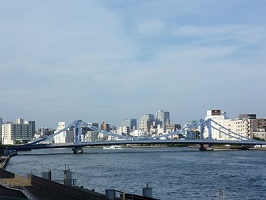
※Kiyosu Bridge seen from Sumida River Ohashi
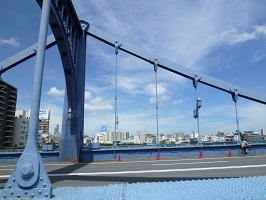
※At Kiyosu Hashigami
Eitai Bridge is said to have been built in Genroku 11 (1698), and was about 150m upstream from now.
It was a large wooden bridge at that time, and it was known as a cool place in summer!
The current bridge is a steel arch bridge that was replaced in Taisho 15 (1926).
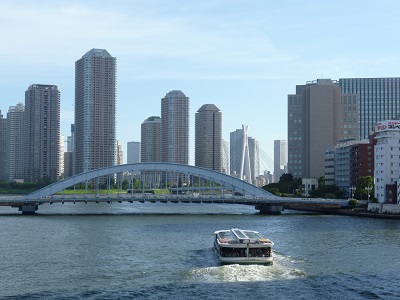
※Eitai Bridge seen from Sumida River Ohashi
In addition, from above the Sumida River Ohashi, the Sky Tree is located over Kiyosu Bridge upstream.
River City 21 in Tsukuda over the Eitai Bridge downstream, and Sumida River Terrace along the Sumida River along the Sumida River.
I was able to enjoy various scenery.
The scenery dyed in the sunset and the illuminated night view are also good for each!

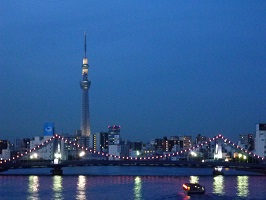
[Taro Edo]
August 20, 2014 15:00
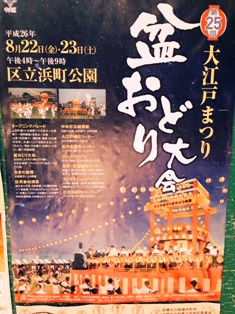 The "Chuo-ku Oedo Festival Bon Odori Tournament" will be held, centered on Bon Odori, which is closely related to the town of Edo, in order to raise the oldness and awareness of inhabitants of the ward and revitalize the area. The "Chuo-ku Oedo Festival Bon Odori Tournament" will be held, centered on Bon Odori, which is closely related to the town of Edo, in order to raise the oldness and awareness of inhabitants of the ward and revitalize the area.
The details are as follows.
Date and time: From Friday, August 22 to Saturday, August 23 from 4:00 pm to 9:00 pm
Location: Tachihama-cho, Chuo-ku Park
Main contents:
1 Opening Parade (only on the 22nd)
17:30~
Ningyocho-dori and amazake Yokocho Intersection → amazake Yokocho → Kiyosubashi-dori Intersection → Hamacho Park
Floats (Hamacho Hayashi), Banners•Side curtain (Nihonbashi Junior High School), tree remains (Edo Fire Memorial Party), children Mikoshi•Balloons (Nihonbashi Elementary School)•Arima Elementary School•Hisamatsu Elementary School, Dance (folk dance Federation)
2 Bon Dance Festival
Dances on the stage by each group
12 songs including Chuo-ku Ondo "This is Edo Bon Dance"
3 Japan Ondo (Only 22nd)
Singing by folk song singers
4 Inhabitant of a ward participation art
Nishiki Shoryu Taisho Koto, Tsukishima Ondo, Kodemmacho Ondo, Hatchobori Ondo, Children's Bon Odori Time (Nihonbashi Elementary School, Arima Elementary School, Hisamatsu Elementary School, Nihonbashi Junior High School),
Nihonbashi Junior High School Brass Band, Nihonbashi GOLDWING
5 Traditional performing arts in Chuo-ku (only on the 23rd)
Bon festival of Tsukuda Island, Hamacho Hayashi, Hamacho Ondo
6 Edo fair Corner
Stores by various groups in the city
7 Specialty City Corner in the City
Bettara City, Toshino City, Setono City
8 Living Corner
Opening of public corporations related to daily life
9 Friendship•Exchange city corner
Special product corner by Higashine City, Fujikawaguchiko Town, Tamano City, Tochigi City, Ishikawa Town, Fukushima Prefecture
10 Antenna Shop Corner
Special product corner by antenna shops in Hokkaido, Aomori, Yamagata, Niigata and Tokushima prefectures
11 Inhabitant of a ward facility PR corner
Opening of Villa Motosu and Izu Highland-so
[Sumida Fireworks]
August 19, 2014 08:10
Night walk scenery on the Sumida River Terrace. Last time, it was the scenery from Ryogoku Bridge to Toyomi Bridge and Eitai Bridge, but this time we will go down to Kachidokibashi.
After passing Eitai Bridge, you will first go to the terrace in the Shinkawa area, where you will go down while watching the beautiful night view.
After passing that place, the relatively new bridge "Chuo-ohashi Bridge" appears.
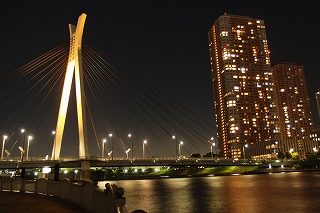
Many bridges on the Sumida River are picturesque, but this bridge is also a beautiful bridge with a beautiful white pillar shape. Since the support is very high, the whole cannot be fit in the photo unless it is far away.
The photo was seen from the downstream side. The building on the right is a group of high-rise apartments called "Okawabata River City 21" on the opposite bank, and the night view is very beautiful.
Looking back on the downstream side, there is "Reigan Island water level station".
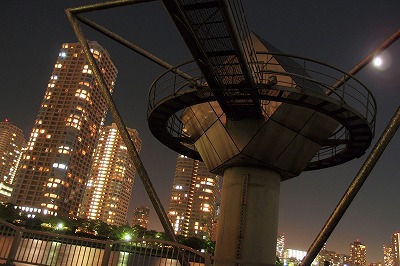
If you look at it at night, it looks like a space station. The three-dimensional observation room in the middle is the shape of a diagonal duode. Depending on where you see it, it looks like it changes to square, square hexagon, and octagon.
The Sumida Terrace is interrupted because the Kamejima River joins the Sumida River again here. Cross "Minami Takahashi" over the Kamejima River.
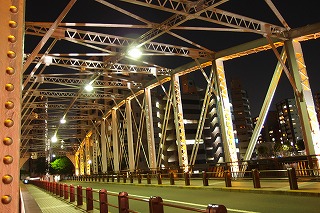
This bridge uses a part of the former Ryogoku Bridge as it is, resulting in a bridge that conveys the appearance of Meiji period today. It feels like it's going through rather than crossing the bridge.
It is the area around Tsukuda Island that goes out on the terrace again and sees on the opposite bank. The monument of Ishikawajima Lighthouse shines.
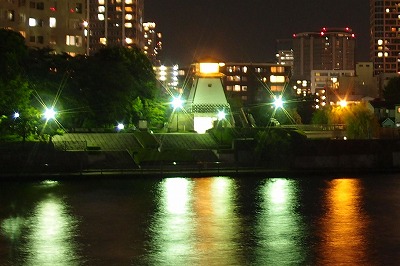 It's good to see the lighthouse at night. It's good to see the lighthouse at night.
After this, go under the Tsukuda-ohashi Bridge and the terrace goes directly below the St. Luke's Tower. From this place, it is the scenery of Tsukuda-ohashi Bridge and Tsukuda Island on the opposite bank.
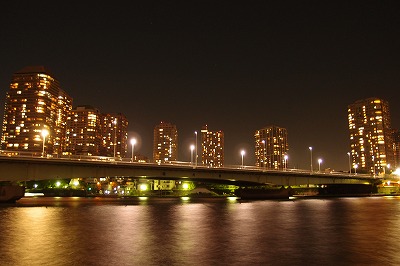 Beyond Tsukuda-ohashi Bridge, there is an old nostalgic cityscape of Tsukuda Island, and if you look at it in this way, you can see that skyscrapers like giants are looking down around it. Beyond Tsukuda-ohashi Bridge, there is an old nostalgic cityscape of Tsukuda Island, and if you look at it in this way, you can see that skyscrapers like giants are looking down around it.
And near Kachidokibashi, the last goal point. The city of Kachidoki, which can be seen on the opposite bank, is a very bright place with high-rise apartments lined up.
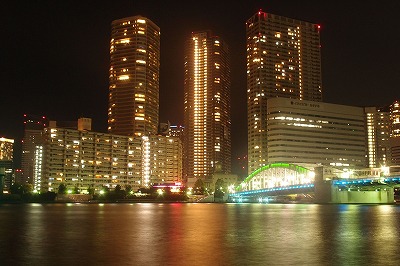 Around Kachidoki, we are currently under construction in various places, and it seems that high-rise tower apartments can be built in the future. I think the scenery of the night will change every moment. Around Kachidoki, we are currently under construction in various places, and it seems that high-rise tower apartments can be built in the future. I think the scenery of the night will change every moment.
As mentioned above, it was an introduction of the scenery from Sumida River Terrace at night twice.
The daytime scenery is wonderful, but at night there is a world that looks different. The same applies to Ginza and Nihonbashi. I hope you will enjoy Chuo-ku at night.
[Sumida Fireworks]
August 12, 2014 09:00
It's hot. Hot days continue.
I like to take a walk, but as expected, walking during the daytime feels dangerous, and in the summer, I often walk while enjoying the night view.
This time, I would like to introduce the night walk scenery from Ryogokubashi on the Sumida River to Kachidokibashi in different times.
First of all, it is the neighborhood of Ryogokubashi, located in the northernmost part of Chuo-ku.
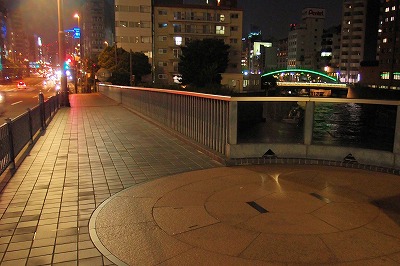
This bridge doesn't have a flashy light-up, but it's not a flashy one.
There are round balconies inspired by the ring, guardrails designed with sumo wrestling and fireworks, and objects like large fireworks balls are sitting on the main pillar ...
It can be said that it is a bridge that can be enjoyed in various ways in Hashigami.
From this Ryogoku Bridge, you can see the light-up of "Yanagibashi" over the place where the Kanda River pours into the Sumida River.
This "Yanagibashi" area is a place that once flourished as a flower town. Perhaps it's a remnant, it's a place where you can still feel the downtown atmosphere, and the night scenery is quite good.
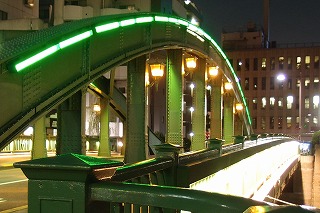
From here, go down the Sumida River Terrace along the river. Then you can see the bridge of the Metropolitan Expressway.
This is a place where red, blue, and yellow light shines on the waterside, but there is an object whose meaning is unknown.
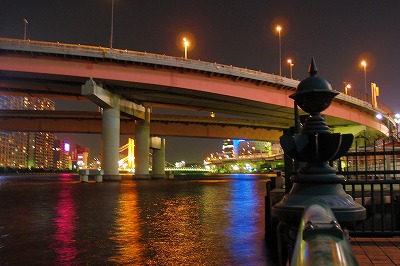
There are two on both sides of Semba, a pleasure boat ride. What are the motifs? An alien?
If you go further downstream, the next thing that appears is Shinohashi, which is very bright. The light reflected in the water is very vivid.
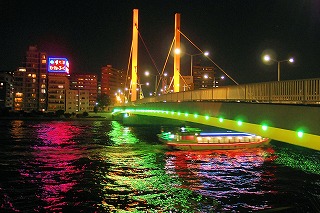
"Kiyosu Bridge" is an elegant form itself, both horizontally and vertically. You can look up at the bridge from the Sumida River Terrace, so it has its own power.
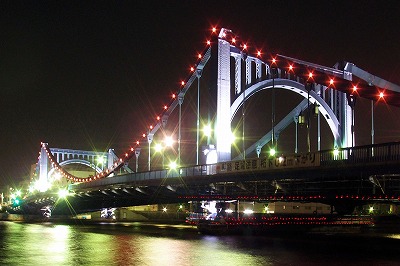
About two years ago, I moved from another prefecture to the vicinity of Kiyosu Bridge, and what surprised me was that the Sumida River was a walking river.
Speaking of the Sumida River, what I was taught at school about 30 years ago when I was a child was like a synonymous with pollution, so that image has remained until now.
However, in fact, the hydrophilic terrace was maintained, making it a space where people could enjoy the waterside as a place to relax. I realized that the image so far was wrong.
Downstream is the Sumida River Ohashi, a two-layer structure.
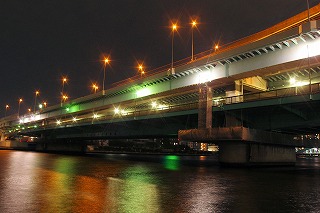
It is a bridge between Kiyosu Bridge and Eitai Bridge, which is important cultural properties of the country, but the Sumida River terrace near this area is bright even at night and the night view is beautiful, so many people enjoy jogging and walking. It's easy to walk.
If you walk further, the Sumida River Terrace will be interrupted once at the location where the Nihonbashi River merges with the Sumida River, so you will have to cross the Toyomi Bridge over the Nihonbashi River and return to the terrace.
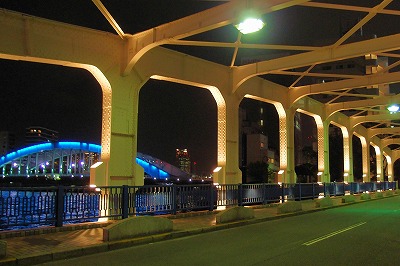 This "Toyomi Bridge" has a unique design that looks like a ladder lying down, but has a small but solid feeling. In the back, you can see the light blue of Eitai Bridge. From here, Eitai Bridge can also be seen as a supporting role. This "Toyomi Bridge" has a unique design that looks like a ladder lying down, but has a small but solid feeling. In the back, you can see the light blue of Eitai Bridge. From here, Eitai Bridge can also be seen as a supporting role.
As mentioned above, this time it was the night scenery of the Sumida River from Ryogoku Bridge to Toyomi Bridge.
Night walks are also quite interesting because you can see a different side of the Sumida River, which is not found in daytime.
This will be the next time. 。 。
[Sam]
August 9, 2014 09:00
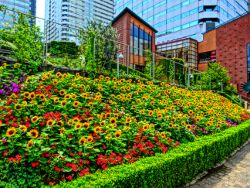  According to the calendar, August 7 is a fall, but it is still at the height of summer. According to the calendar, August 7 is a fall, but it is still at the height of summer.
Yellow, orange, and red flowers are in full bloom on Harumi Triton's "Flower Terrace" as if challenging the summer sun.
This year, the dwarf sunflower "Good Smile" appeared in the "Slope Garden" along the Asashio Canal, making it even more gorgeous.
Speaking of "Himawari", it is common to image that large yellow flowers bloom at the tip of tall stems, but recently the flower color is yellow to brown, the height is high to dwarf species, and the flower shape is large to small flowers / single bloom ~ double-flowered.
In addition, Ludpo Kia 'Takao' (1), Ludpo Kia' 'Plaley San' (2), Ludpo Kia' 'Autum Color' (3), Echinacea' Cheyenne Spirit' (4), dahlia' Black Butterfly (5), Lantana' Camarathan (7), hibiscus, 6, and so on.
In the park, you can enjoy a total of four species, including the red flower species of "Salsberg", a flowering tree that represents summer, and the dwarf horticultural species.
① ② ③ ④ ⑤
    
⑥ ⑦ ⑧ ⑨ ⑩
    
[Edo Tabi Taro]
August 8, 2014 14:00
■Ginza Noh Kin Spring Festival in summer.
□July 31 is eve festival. Kinharu Street at dusk.
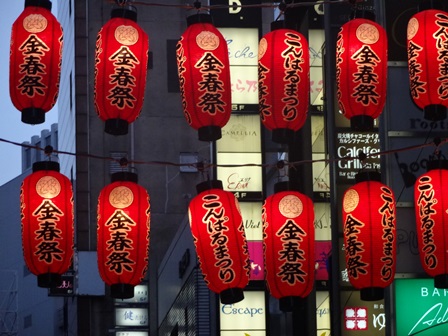
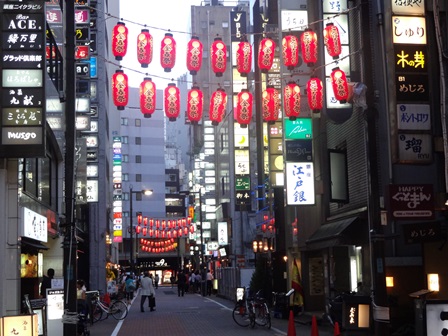

□Kinharu Inari Daimyojin at the "Toya" store. From July 31 to August 7, Shimbashi Kaikan is here.
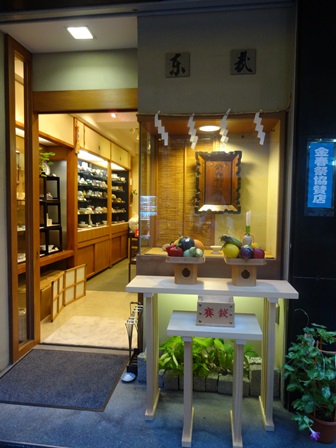
□The lottery venue in front of "Toya".
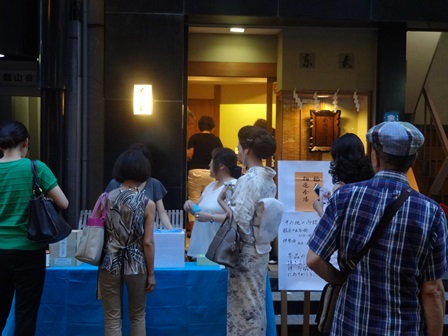
□Tasting venue in front of "Ise Yu". "Kinharu Fiz" developed by "Bahoshi" is now available. It was delicious!
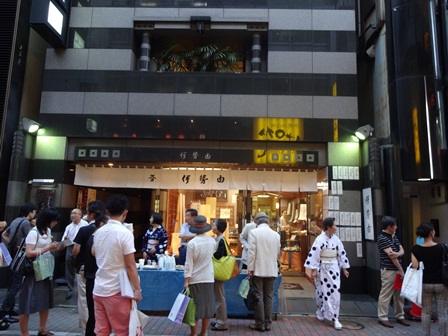
□From August 1st to 7th, the Noh Photography Exhibition (photo by Seiichiro Tsujii) was held on the first basement floor of the Tachikawa Ginza Showroom.
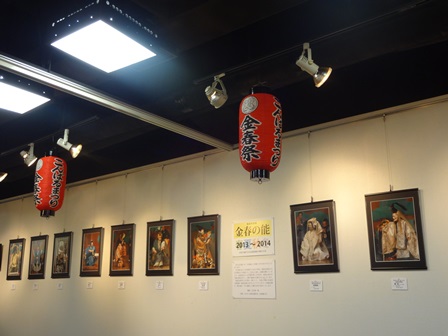
■From August 1st to 6th, "Noh Lecture by Noh Performers" was held every day at the venue.
I participated in the "Experience Course Song" on August 6. Under the guidance of Mr. Hotaka Kinharu, I learned with the people who participated in the song of "Shojo".
■On the evening of August 7, a street dedication Noh was served on Kinharu Street.
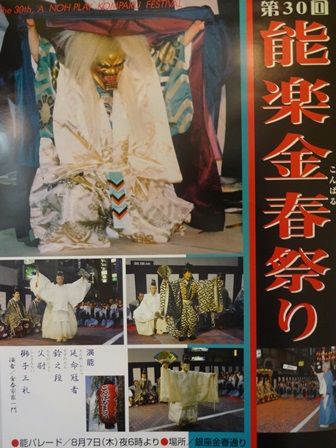
□On the 7th, from the front of Kinharu Inari Daimyojin "Toya", we moved to the first floor of "Ginza 888 Building".
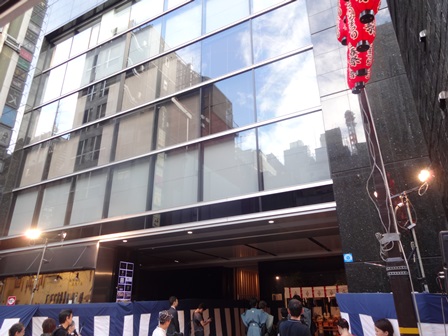
□Normally, Kinharu-dori, where people and cars come and go, was closed, and the construction of the venue began.
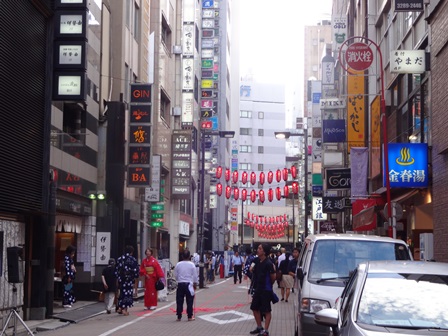
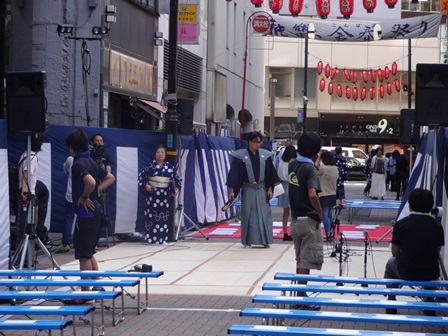
□A large number of customers who sit and wait for the start.
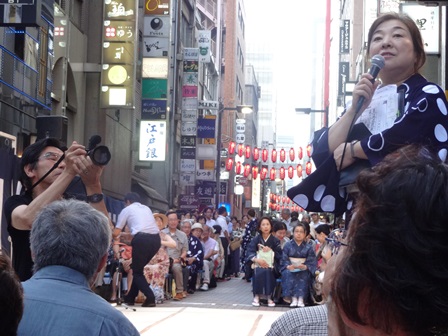
■The dedication Noh was initiated by the town council officers, and was started with the voice of "Hashinai" by Mayor Yoshihide Yada, the mayor of Noh magistrate.
This time is the fifth year of every year, so "Shishisanrai" was also served.
There was also a refreshing wind, and I was able to comfortably immerse myself in the world of Yugen (noh is not photographed because of the ritual Noh).
□People who visit altar on the first floor of the Ginza 888 Building after the end.
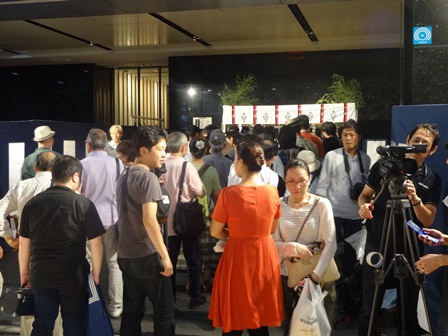
□Kinharu Street after the end.
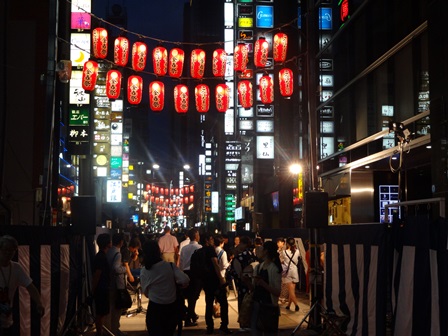
■This event is related to Kinharu Yashiki (3,000 tsubo), which occupied the entire current Ginza 8-chome 6, 7, and 8 during the Edo period.
Next summer, be sure to go to Kinharu Street.
|
Links
|
![]()
![]()
 The "Chuo-ku Oedo Festival Bon Odori Tournament" will be held, centered on Bon Odori, which is closely related to the town of Edo, in order to raise the oldness and awareness of inhabitants of the ward and revitalize the area.
The "Chuo-ku Oedo Festival Bon Odori Tournament" will be held, centered on Bon Odori, which is closely related to the town of Edo, in order to raise the oldness and awareness of inhabitants of the ward and revitalize the area.


 It's good to see the lighthouse at night.
It's good to see the lighthouse at night. Beyond Tsukuda-ohashi Bridge, there is an old nostalgic cityscape of Tsukuda Island, and if you look at it in this way, you can see that skyscrapers like giants are looking down around it.
Beyond Tsukuda-ohashi Bridge, there is an old nostalgic cityscape of Tsukuda Island, and if you look at it in this way, you can see that skyscrapers like giants are looking down around it. Around Kachidoki, we are currently under construction in various places, and it seems that high-rise tower apartments can be built in the future. I think the scenery of the night will change every moment.
Around Kachidoki, we are currently under construction in various places, and it seems that high-rise tower apartments can be built in the future. I think the scenery of the night will change every moment.





 This "Toyomi Bridge" has a unique design that looks like a ladder lying down, but has a small but solid feeling. In the back, you can see the light blue of Eitai Bridge. From here, Eitai Bridge can also be seen as a supporting role.
This "Toyomi Bridge" has a unique design that looks like a ladder lying down, but has a small but solid feeling. In the back, you can see the light blue of Eitai Bridge. From here, Eitai Bridge can also be seen as a supporting role.
























